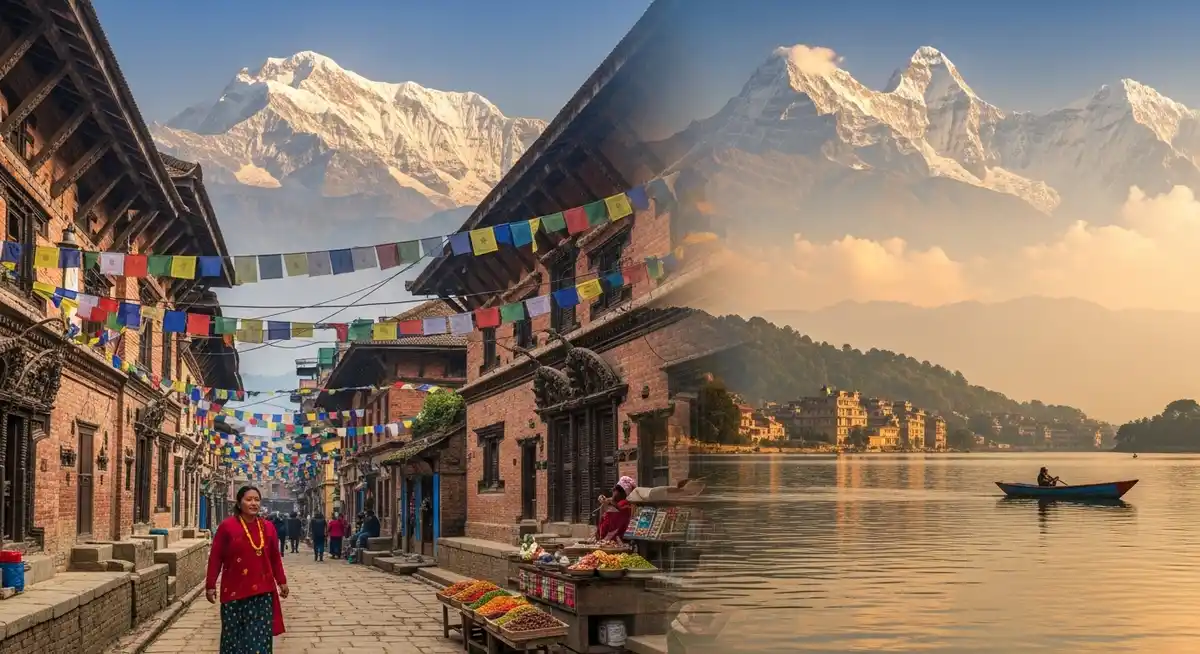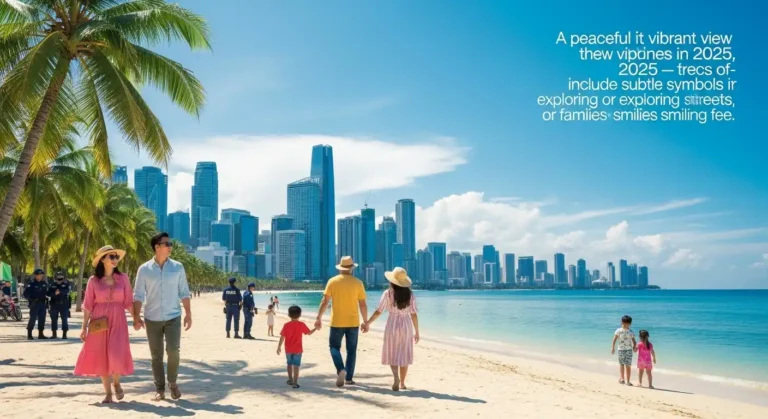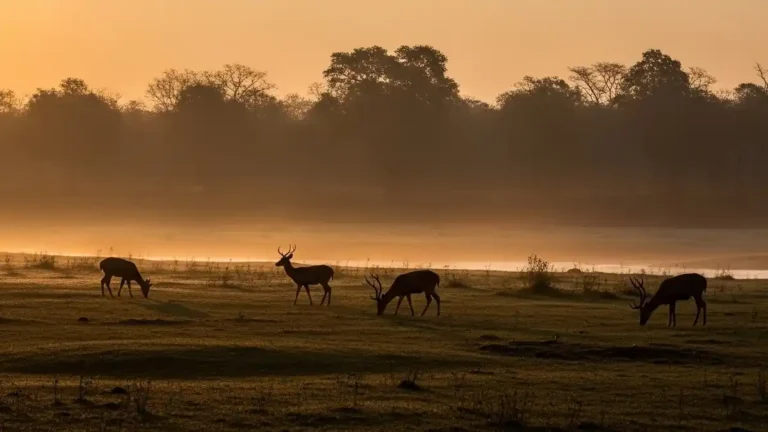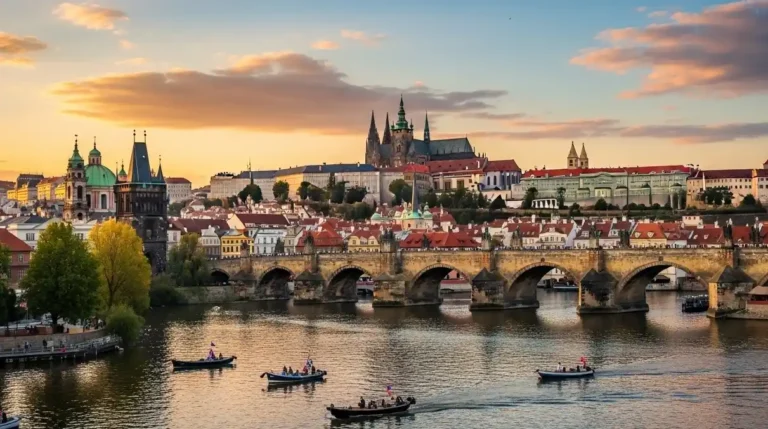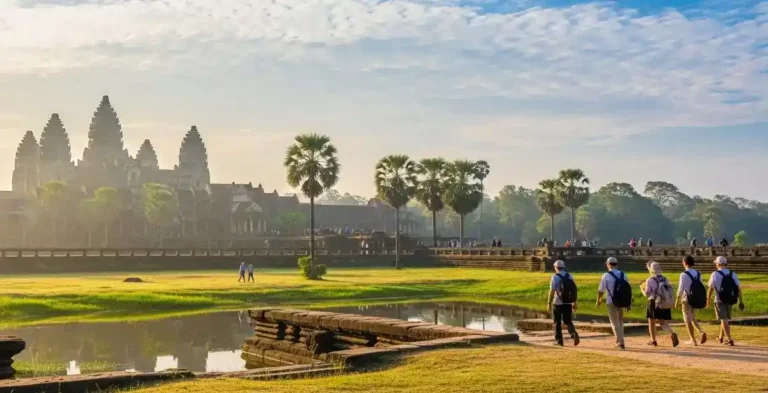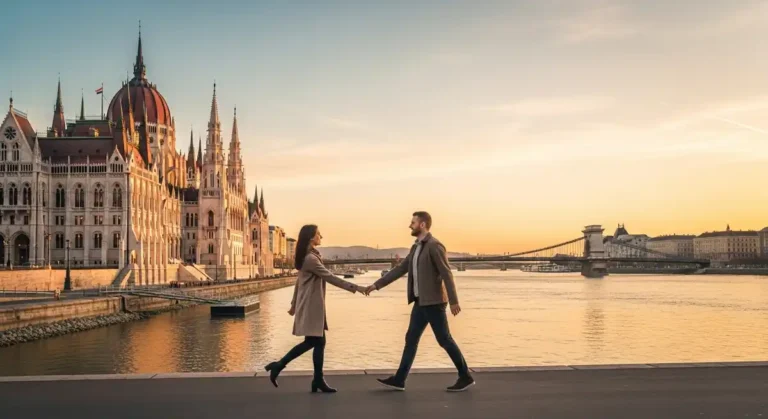Is Nepal Safe to Visit in 2025? (Full Safety Guide for Tourists, Trekkers & Expats)
Dreaming of Nepal? In 2025, this Himalayan gem offers more than just breathtaking views—it promises peace of mind. From serene lakes to bustling bazaars, here’s how to explore with confidence and make every moment unforgettable.
Nepal is a safe and welcoming destination for tourists, offering warm hospitality, beautiful atmosphere, and memorable travel experiences in places like Kathmandu and Pokhara. The crime rate is low, tourism services are well-developed, and local guides ensure an enjoyable and safe trip.
Nepal offers a rich mix of culture, nature, and hospitality that makes it a favorite destination for tourists. From the bustling streets of Kathmandu to the serene lakeside of Pokhara, the welcoming atmosphere creates an enjoyable trip for all visitors.
- General Safety – Nepal is a safe and welcoming destination with low crime rates, warm hospitality, and well-developed tourism services in hubs like Kathmandu and Pokhara.
- City & Regional Safety – Major cities (Kathmandu, Pokhara) and trekking hubs (Lukla, Namche Bazaar, Jomsom) are generally secure; use licensed guides and registered transport.
- Travel Precautions – Keep belongings secure, use copies of important documents, walk in well-lit areas at night, and exchange currency at authorized places.
- Trekking & Adventure – Hire licensed guides, acclimatize gradually, check weather forecasts, carry insurance covering rescue, and stay hydrated.
- Health & Hygiene – Drink bottled/filtered water, eat freshly cooked meals, use insect repellent in warmer regions, and be aware of altitude sickness prevention.
- Transport Safety – Travel in daylight, choose reputable buses, jeeps, or taxis, wear seatbelts where available, and secure your belongings.
- Natural Hazards – Be prepared for earthquakes, landslides, and monsoon weather; carry basic emergency supplies.
- Political Situation – Demonstrations are generally peaceful; avoid large gatherings and follow local guidance during political events.
- Inclusive & Cultural Respect – Nepal is increasingly LGBTQ+ friendly; respect local customs by dressing modestly, greeting with “Namaste,” and avoiding public displays of affection.
- Best Time to Visit – Autumn (Sept–Nov) and spring (Mar–May) offer stable weather and ideal trekking conditions.
- Entry & Health Prep – Most travelers get a visa on arrival; update routine and travel vaccines, and prepare a small health kit.
- Common Risks & Avoidance – Prevent altitude sickness, avoid street scams by using licensed services, and carry insurance for health and adventure activities.
Local guides share their wealth of knowledge, helping you discover both popular tourist hubs and hidden gems while feeling in good hands.
The country has made great strides in improving safety features and facilities, with strong efforts from tourism stakeholders. Travelling here is supported by experienced guides, modern transport, and continuous upgrades that enhance every part of the journey.
Whether exploring remote mountainous areas or enjoying the vibrant city life, staying informed and appreciating the local culture ensures a truly memorable visit.
Do you want me to now also rewrite this in a slightly more conversational style so it feels more personal while still perfect for SEO? That could help match Google’s helpful content standards even better.
Nepal Safety by Category (2025)
1. Crime & Personal Security
Traveling in Nepal can be safe and rewarding with mindful planning. Here’s how to enjoy your trip while staying confident and prepared.
Practical Tips for Visitors
- Keep personal belongings close in tourist sites, airports, buses, and hotel rooms.
- Use a copy of your passport instead of the original when exploring.
- Walk on footpaths away from the curb and keep your bag on the side away from traffic.
Navigating Cities and Tourist Areas
- Popular spots like Thamel, Durbar Marg, Sanepa, and Kupondol are lively and full of culture. Enjoy the atmosphere while being aware of crowded areas.
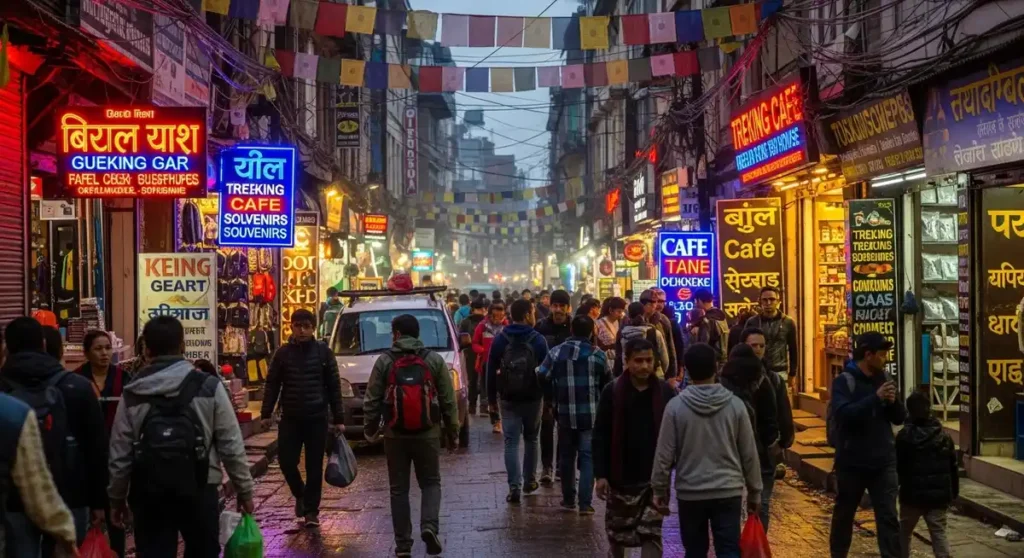
- In the evening, choose well-lit main roads and keep valuables in a hotel safe.
- Use government-registered guides, hotels, and tours for added assurance.
Trekking and Adventure
- Book trekking safety with a professional guide and choose safe routes in mountain regions.
- Stay informed about weather conditions, especially at high altitudes.
- Carry insurance that covers emergency rescue and keep documents secure.
Staying Connected and Informed
- Exchange currency at authorized places and keep a small sum of cash in multiple spots.
- Use trail apps for remote paths and follow advice from hotel staff or your trekking agency.
Preparedness for Natural Surroundings
- Be aware of natural disasters like earthquakes and landslides in this seismically active area.
- Check weather forecasts in the monsoon season and know evacuation routes.
- For longer trips, carry medicines, bottled water, and a torch.
Extra Personal Measures
- Keep a personal alarm or whistle on remote trekking trails.
- Women travelers may choose to wear a ring or wedding band, or carry a couple photo to enjoy stress-free travel.
2. Political Situation & Civil Unrest
Nepal’s political events and election periods are a vibrant part of its democracy. These may include demonstrations, protests, and strikes, which are often peaceful and community-focused.
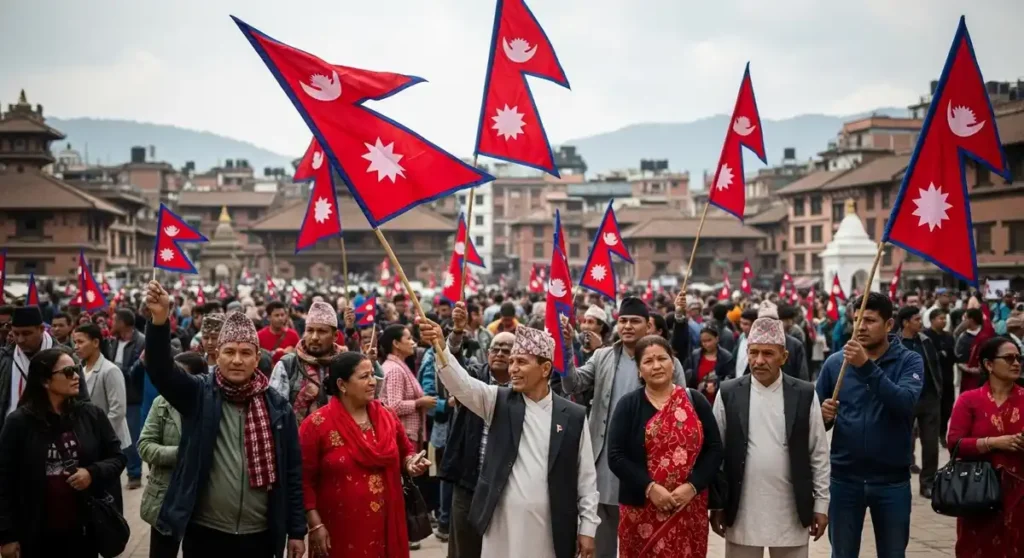
Key tips for travellers:
- Follow local authorities’ guidance during large gatherings.
- Keep track of media updates on areas with roadblocks or curfews.
- Plan travel routes to avoid delays in road travel or at trekking areas.
- Respect government buildings and cultural spaces during public events.
The country’s historical context, including the Maoist insurgency, reflects its journey toward stronger democratic systems and political stability, creating a dynamic atmosphere for visitors to explore.
3. Natural Hazards & Environmental Risks
Nepal’s location in the Himalayas and its rugged terrain provide breathtaking scenery and unique adventure opportunities. The country experiences earthquakes, landslides, floods, and severe weather, especially during the monsoon season from June to September.
Safety practices in natural environments:
- Keep an emergency kit with first aid, water treatment tablets, and bottled water.
- Be aware of avalanches, storms, blizzards, and seasonal tremors.
- Explore rural areas with guidance from locals who understand climatic conditions.
- Stay informed about rare events like glacial lake outburst floods (GLOFs) or droughts.
Nepal’s position on the Indian tectonic plate and Eurasian tectonic plate shapes its landscape and biodiversity. Conservation efforts help prevent environmental damage, habitat destruction, and forest fires, while its people’s agricultural dependence reflects harmony with nature and resilience to natural disasters.
4. Health & Hygiene Safety
Traveling in Nepal offers memorable experiences, and with a few simple habits, it’s easy to stay healthy. When exploring higher altitude areas above 2,500m, taking time to adjust ensures you can fully enjoy the mountains and fresh air without discomfort.
In warmer regions like the plains and terai, using insect repellent, wearing light long-sleeved clothes, and taking recommended vaccines protects against conditions such as malaria and Japanese encephalitis. I always carry a small kit with repellent and a water bottle for peace of mind.
Food and water safety is essential. Opting for boiled or bottled water and eating freshly cooked meals instead of raw or undercooked dishes keeps you energized for your adventures. Fresh fruits like bananas are fine, but washing them with clean water makes them even safer.
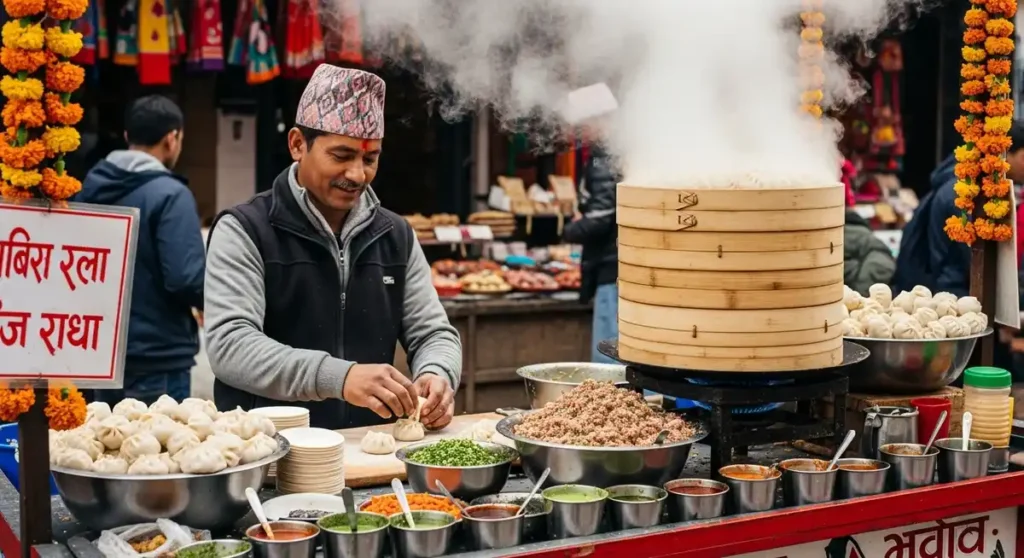
Animal encounters are part of Nepal’s charm, especially in areas like Kathmandu where monkeys are common. Watching them from a distance is not only respectful but also prevents risks like rabies.
Nepal’s HHS health protocols and Labour safety laws (2074, 2075, 2081) mean that hotels, restaurants, and the tourist sector follow strict cleanliness standards. These measures make it easier to relax and focus on enjoying the journey.
5. Transportation Safety
Getting around Nepal is part of the adventure. Buses, jeeps, and micro-buses connect destinations like Pokhara, Sallery, and the valley with routes that pass through the plains, mountains, and along rivers.
Traveling in daylight is the best way to enjoy the scenery—from terraced fields to winding roads with gentle bends. It also gives time to stop for a barbecue lunch or admire the views along the way.
Transport options range from budget-friendly public buses to private jeeps and tourist buses. Prices vary from around 400 to 20,000 rupees depending on comfort, distance, and whether you’re heading to popular spots like Pokhara or trekking start points in the mountains. Mini-vans and micro-buses are often faster, while local buses give a closer look at daily life.
Drivers in Nepal are skilled at navigating winding paths, hairpin bends, and varied surfaces, making journeys both safe and enjoyable. Passengers can add to the safety by keeping belongings secure, wearing seatbelts if available, and respecting local rules.
Whether moving through the busy streets of Kathmandu or the quiet plains, choosing the right transport and timing the trip well helps make travel smooth and memorable.
6. Trekking & Adventure Activity Safety
Nepal, the home of the majestic Himalayas, houses the highest mountain peaks in the world, including Everest. The trekking and mountaineering adventures here offer high-altitude routes that are both culturally and naturally enthralling. This Himalayan country gives countless exploration prospects for every trekking enthusiast.
For trekking safety in Nepal, travelers can follow trusted factors and protocols. Hiring licensed guides from reputable agencies ensures expert advice and secure journeys. Being hydrated, acclimatizing to altitude, and having a travel insurance policy that includes emergency coverage are key.
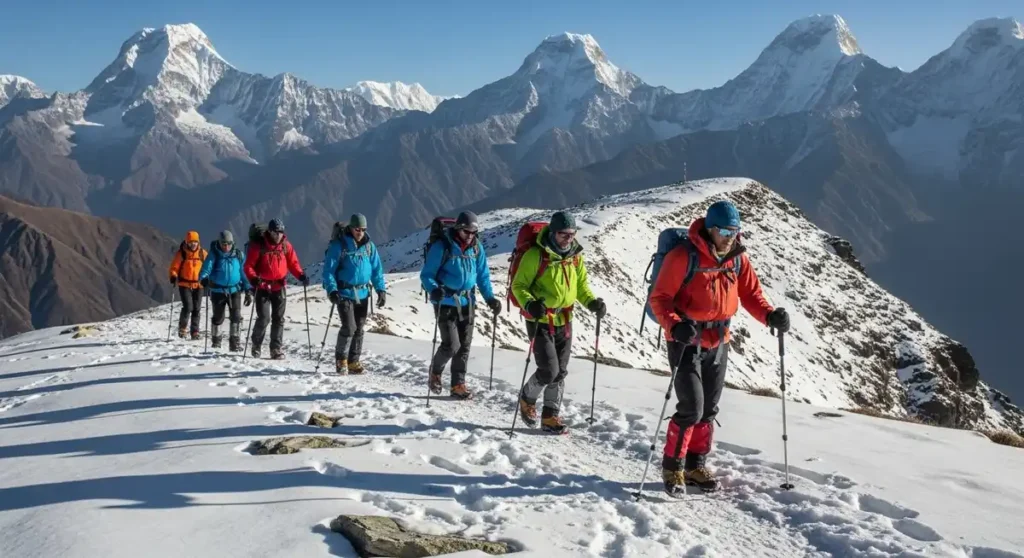
Precautions include gradual altitude acclimatization, rest days, and using the climb high, sleep low method to prevent altitude sickness. Carrying safety gear, a first-aid kit, pulse oximeter, and checking weather forecasts before travel help maintain comfort and security.
Adventure activities are made safer by following rules of the mountains, working with local guides like Bibek, and ensuring the activity provider meets safety requirements. Using life jackets, seatbelts, and proper equipment adds an extra layer of assurance.
7. LGBTQ+ & Minority Traveler Safety
Nepal is a paradise with rich landscapes, Nepalese values, beliefs, and culture. It warmly welcomes travelers from all walks of life, with increasing openness toward the LGBTQ+ community. The destinations here blend scenery, cultural heritage, and a spirit of acceptance.
LGBTQ+ travel in Nepal is both safe and enriching, offering a mix of adventure and cultural immersion. Popular places like Phewa Lake in Pokhara, Pashupatinath, and Swayambhunath in Kathmandu offer serenity and spiritual charm. Cafes and shops run by the community create a warm atmosphere.
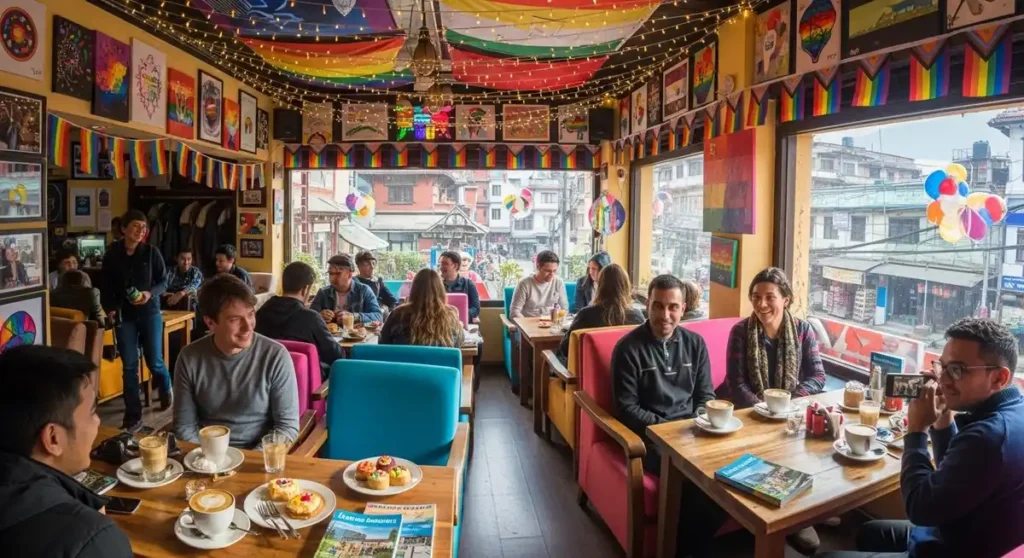
The Nepalese Constitution recognizes rights of LGBTQ+ people, with laws protecting sexual orientation and gender identity. This progress supports inclusion and ensures a respectful travel environment.
Local guides like Sunil Babu Pant enrich the experience with heritage tours featuring temples, stupas, paintings, and carvings that reflect the nation’s traditions. Incense, chiya, and traditional breakfast foods like gwara mari and malpuwa add sensory depth to the journey.
Nepal’s Tourism Board and Nepal Mountaineering Academy also provide trekking guide training for LGBTQ individuals, allowing travellers to connect with guides who share their values. Younger Nepalese in cities and towns are often expressive and embrace Western clothing, adding to the friendly and inclusive vibe.
Safety by Traveler Type
1. Tourists
Nepal is known as a peaceful country where tourists feel welcomed. Its strong hospitality and beautiful traditions make it a favorite spot for foreign visitors. The vibrant streets of Thamel and scenic trails offer plenty to explore. With planning, awareness, and good decisions, you can travel freely and enjoy each journey.
Many tourists also choose to visit famous spots like the Annapurna Circuit or Everest Base Camp with licensed guides for an enriched experience.
2. Solo Travelers
Nepal is relatively safe for solo travelers, offering inspiring trekking success stories and supportive locals. Choose secure accommodations such as hotels or guesthouses with good locks, and share your itineraries with family or friends. Using a local SIM card helps with communication, maps, and staying connected.
Respecting customs and traditions, dressing modestly, and showing cultural respect ensure a positive connection with the community. For health and gear, carry a first-aid kit, needed medication, and essentials for altitude sickness when at higher elevations.
3. Solo Female Travelers
Nepal is an excellent choice for solo female travellers seeking both adventure and peace. My personal verdict is that the country feels safe and easy to explore. I walked through Kathmandu’s alleys and shortcuts, joined Grab bikes through traffic, and enjoyed a seamless journey. The people are kind, the tourist trail is easy to follow, and the calm atmosphere makes even busy areas manageable.
Whether it’s sipping masala tea in a courtyard or putting on hiking boots for a mountain adventure, you’ll find countless enriching experiences. Nepal ranks among the safest destinations in Asia for women, with respectful locals and welcoming travellers. Keeping a common sense approach and choosing accommodation with a lively social scene can enhance the journey, offering chances to meet new friends and join hikes with guides or good company.
4. Families with Children
For families and children, Nepal blends protection, health, and family-friendly fun. Tours often include child-focused activities like trekking, wildlife spotting, and exploring the countryside. With improved transportation, communication, and road conditions, families can enjoy a smooth travel experience.
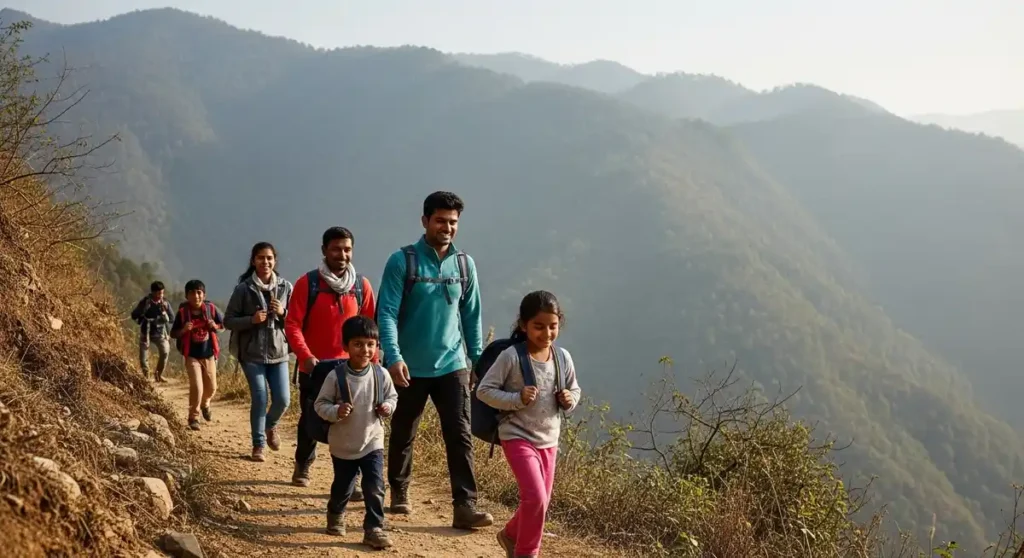
Keeping hygiene in mind, ensuring vaccinations, and choosing safe food and water options make the trip even more enjoyable. Many destinations in Nepal are designed to be friendly, with protective factors for younger travelers. From vibrant markets to peaceful mountains, the adventure feels both exciting and comfortable for all ages.
5. Expats & Long-Term Visitors
Nepal offers a peaceful and welcoming environment for foreigners, expats, and long-term visitors, where daily life blends comfort with cultural richness. Areas like Patan, Baluwatar, and Lazimpat in Kathmandu are among the safest, with many INGOs, embassies, restaurants, and bars adding to their charm.
The local population is warm and friendly, making it easy to feel at home while enjoying the vibrant community atmosphere. Moving around is effortless with registered taxis, reliable agencies, and licensed tour operators, while drinking bottled or purified water keeps life healthy and comfortable.
Life here is enhanced by low tourist crime rates, a strong sense of hospitality, and the availability of comprehensive travel insurance for medical care when needed. The healthcare system, along with private treatment options, supports both routine needs and emergencies.
Keeping important documents, valuables, and cash secure, as well as registering with your consulate or embassy, helps ensure peace of mind during your stay. Communication is made easy with English widely spoken, especially in the tourism sector, and learning basic Nepali phrases can greatly enhance the overall experience.
Daily life is enriched by deep cultural connections and mutual respect for customs. Choosing to dress modestly, avoiding public displays of affection, and greeting with a Namaste gesture as a respectful alternative to handshakes or hugs helps build warm social interactions.
The country’s diverse environment and pleasant climate offer countless opportunities for exploration, from the bustling streets of the capital to scenic trekking trails that reveal the natural beauty of Nepal. Every day here feels like a chance to discover, connect, and truly belong.
City & Region-Specific Safety
Is Kathmandu Safe?
Kathmandu is safe for visitors, including solo female travelers. Popular areas like Thamel, Lazimpat, Baluwatar, and Patan are well-known for their welcoming culture, friendly locals, and secure environment.
Using trusted taxi apps like Pathao, InDrive, or Uber ensures fair prices and convenience, while public transport and walking in main tourist spots are generally safe day and night.
Kathmandu offers a warm and welcoming atmosphere that makes travellers feel at ease. In places like Thamel, you’ll find lively bars, cozy restaurants, and comfortable hotels.
Many people walk around even at night, often with friends, enjoying the vibrant streets. Taxi services are reliable, and with apps such as Pathao, InDrive, or Uber, you get a set price without needing to negotiate.
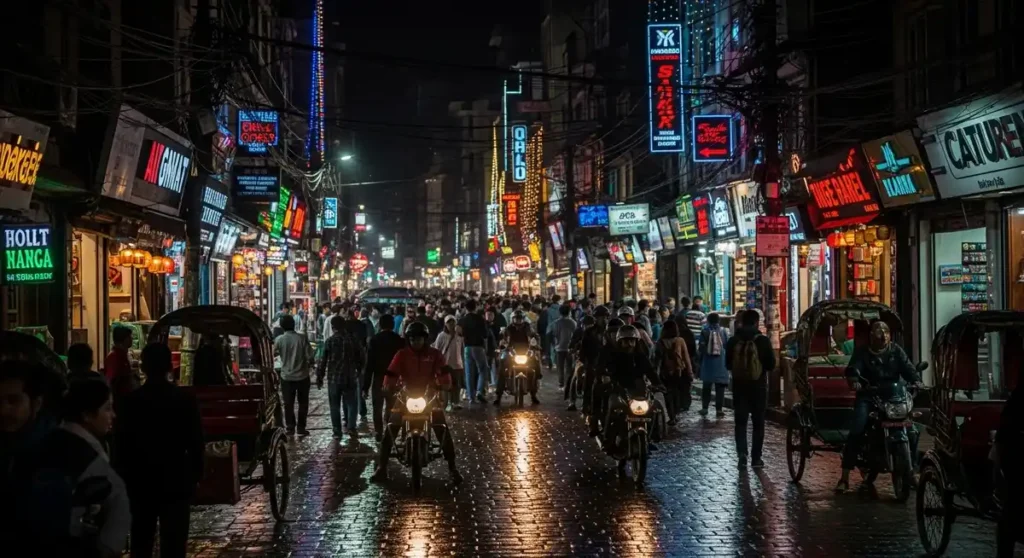
Visitors enjoy public transport, though many prefer local taxis for shorter stays. Areas such as Baluwatar, Lazimpat, Patan, Lalitpur, and Jhamsikhel are considered among the safest parts of the city, with many cafes, attractions, INGOs, embassies, and expats. The culture here is friendly and helpful, with Nepali people often starting a conversation just to assist.
The crime rate is low, and many compare it favorably to cities like London in Europe or the U.S. Whether exploring markets, enjoying trekking, or visiting shops and tourist attractions, Kathmandu makes it easy to feel safe and welcome throughout your trip.
Pokhara Safety
Pokhara is considered one of the safest cities in Nepal, especially for solo female travelers. It offers a welcoming environment, friendly locals, reliable transportation options, and a peaceful atmosphere, making it an ideal destination for visitors.
Ranked among the safest places in Nepal, Pokhara combines natural beauty with a calm, secure environment. Solo female travelers often highlight the city’s friendly and respectful locals, as well as its supportive tourism infrastructure.
The city is a hub for adventure tourism and the starting point for the famous Annapurna Circuit trek. It also offers cultural attractions like the International Mountain Museum, World Peace Pagoda, Sarangkot viewpoint, and several other museums showcasing local history, culture, and nature.
Visitors enjoy a wide range of accommodations, from luxury 5-star hotels to budget-friendly stays, ensuring comfort and convenience. Transportation is generally reliable, with taxis, buses, and rickshaws easily available for daytime travel.
With low crime rates, a relaxed vibe, and proactive local authorities maintaining a secure environment, Pokhara stands out as a destination where travelers can explore freely and feel safe throughout their stay.
Trekking Hubs (Lukla, Namche Bazaar, Jomsom)
The safety of trekking hubs like Lukla, Namche Bazaar, and Jomsom is supported by proper precautions, gradual acclimatization, and good hydration habits, with well-planned routes and comfortable rest days ensuring a smooth journey for all trekkers.
Exploring trekking hubs in Nepal such as Lukla, Namche Bazaar, and Jomsom can be a pleasant and well-prepared experience. These places offer structured routes, helpful Base Camp Treks services, and enhanced safety through gradual acclimatization and rest days.
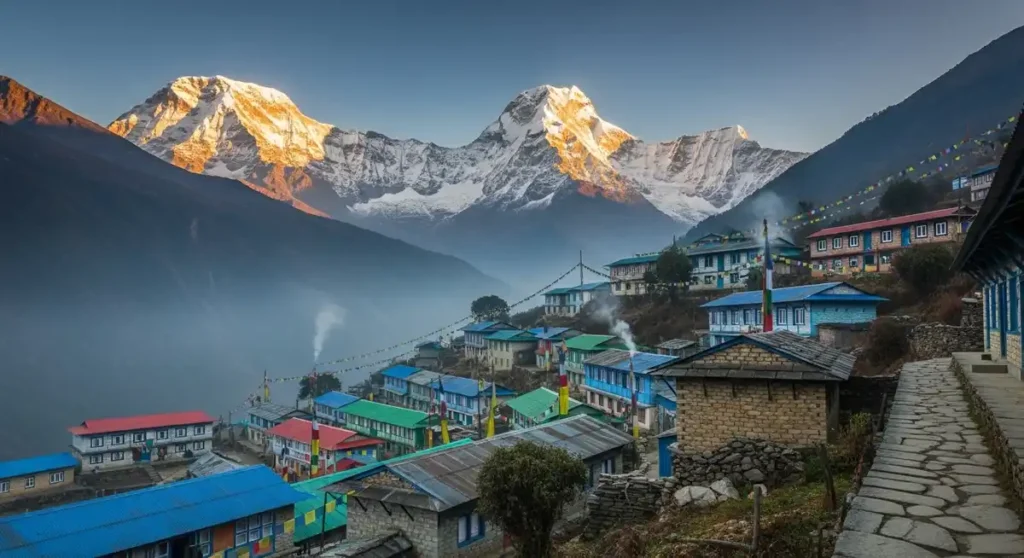
The Khumbu region provides essential stops to adjust to higher elevations, making the journey comfortable for both experienced trekkers and those with younger children.
During the journey, staying hydrated by drinking a few liters of water daily helps maintain oxygen levels at high-altitude location points. Travelers often minimize alcohol and caffeine to support hydration and energy. Travel insurance can add peace of mind for potential schedule disruptions.
With a good pace, regular breaks, and mindful preparation, even monsoon or winter seasons can be enjoyed while experiencing the vibrant culture and natural beauty of these famous hubs.
Lumbini & Cultural Sites
Lumbini and Nepal’s cultural sites are safe, peaceful, and popular for tourists and pilgrims. With easy accessibility through the Gautam Buddha International Airport and well-connected highway, visitors enjoy heritage and historical structures like Mayadevi Temple, Sacred Garden, Patan Durbar Square, and Boudhanath in comfort.
Visiting Lumbini is a special experience. It is a holy place for Buddhists and a spiritually significant destination for tourists from worldwide. Every year, million visitors come annually to enjoy its beauty. The Gautam Buddha International Airport and a smooth highway make accessibility simple for travelers.
The Mayadevi Temple, Sacred Garden, and other cultural sites in the Kathmandu Valley—such as Patan Durbar Square, Changu Narayan Temple, Swoyambhunath Stupa, and Boudhanath—are all popular and safe. Their heritage and historical structures attract people for preservation and appreciation.
During your trip, it’s good to be informed with advisories, stay prepared, and enjoy the culture and customs respectfully. With friendly locals, beautiful surroundings, and a warm welcome, these places offer an unforgettable journey into Nepal’s rich history and traditions.
Common Tourist Risks & How to Avoid Them
Common tourist risks in Nepal include changes in altitude, busy crowded areas, and varied weather conditions. Travelers can stay safe by choosing reputable transport, keeping belongings secure, practicing good hygiene, and carrying insurance for medical needs. Drinking purified water, planning trekking with proper acclimatization, and staying informed about weather helps avoid issues.
Travel in Nepal is full of beauty and adventure. Some areas are crowded and congested, so keeping belongings close and using a money belt is wise.
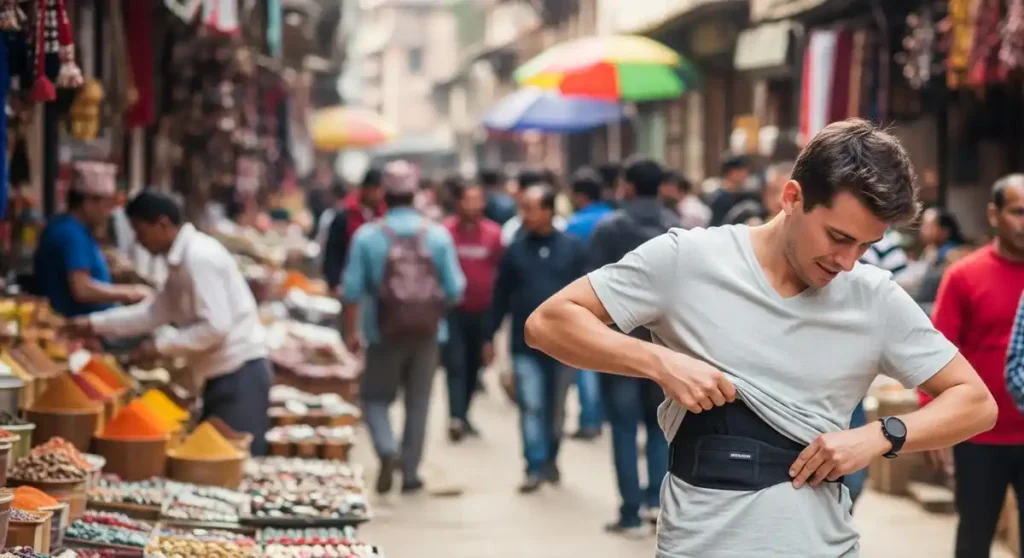
Always use reputable transportation services, especially for buses or flights, to enjoy a smooth trip.
The mountains offer wonderful trekking, but altitude changes mean travelers should take time for acclimatization. This ensures a safe and enjoyable trek. Keeping preparedness in mind and packing a small first-aid kit can make a trip easier.
Being informed about weather patterns and road hazards helps travelers plan better routes. During monsoon season, floods and landslides can affect schedules, so planning ahead is important.
Carrying insurance that covers medical needs, evacuation, and adventure activities adds peace of mind. Staying in hotels with good safety standards and traveling with friends or family can enhance the experience.
Food & Water Safety
Eating in trusted restaurants keeps meals enjoyable. Choose freshly prepared food and drink only purified or bottled water. Avoid drinking from the tap to maintain good health.
Washing hands before meals and maintaining hygiene during travel adds to a healthy experience.
Altitude Sickness
Higher altitude areas in Nepal offer stunning views. For safe travel, increase height gradually and focus on proper acclimatizing. Drink enough water, eat light food, and consider mild medication if recommended by a doctor.
When trekking in remote areas, travel with companions and stay informed about your route. This ensures both safety and enjoyment in Nepal’s mountains.
Street Scams in Nepal
While Nepal is welcoming, visitors may meet friendly locals offering help or guiding to shops and restaurants. Many guides work hard and provide great service. Choosing licensed and reputable guides, checking prices before purchase, and confirming fares for taxi rides keeps travel smooth.
When using ATM services, choose machines at trusted hotels or major cities. Vendors in popular areas often have quality goods; simply checking the price first helps maintain a fair deal.
How to Avoid Scams in Nepal
Enjoying Thamel and Durbar Square can be memorable with a little preparation. Friendly chats in English or compliments on sunglasses may lead to shopping opportunities—browse freely, and bargain politely.
For taxis, using Pathao, Uber, or other fixed fare services ensures clear price agreements. Carrying exact change is helpful for smooth transactions.
Keeping belongings secure in crowded areas and staying polite during any conversation keeps the day pleasant and relaxed.
Safety Tips for Visiting Nepal in 2025
Traveling to Nepal in 2025 can be an incredible experience filled with beautiful mountains, friendly people, and rich traditions. By following a few simple practices, you can make your journey smooth and enjoyable.
Respect Local Culture
Nepal is known for its warm hospitality and deep traditions. Dress modestly in religious places such as temples. A light scarf or long sleeves can help you blend in. Greet people with a friendly Namaste—it shows respect and goodwill.
Travel Prepared
If you plan to trek or go hiking, join a group or hire a licensed guide. Check your kit before departure and ensure your documentation and insurance are up to date. A small first aid kit and a reusable water bottle are must-haves.
Stay Comfortable and Healthy
Keep yourself hydrating throughout the day. Choose clean food spots with good hygiene and avoid untreated water—opt for bottled or filtered water. Dressing in layers will help you stay comfortable in extreme weather.
Protect Your Belongings
Keep valuables like cash, jewellery, and travel bag close to you. Use locks for your luggage, and choose accommodations with secure storage.
Use Reliable Services
When using transportation, pick registered taxis or travel operators. Book through trusted agencies for tours and trekking experiences.
Be Informed
Check updated weather conditions, local events, and travel notices. Having local contacts and knowing nearby medical centers can make your trip smoother.
Key Tips in Short:
- Dress with modesty in sacred places
- Greet locals with Namaste
- Trek with a group or guide
- Carry a kit and stay hydrating
- Choose clean food and water
- Keep valuables secure
- Use registered transport
- Stay aware of weather and local updates
Practical Information for a Safe Trip
1. Best Time to Visit Nepal for Safety
The best time to visit Nepal for safety is during the dry autumn months of September to November and spring from March to May. These seasons offer stable weather, clear skies, and excellent visibility, making them ideal for trekking, sightseeing, and travel.
Travel in the dry seasons ensures ideal conditions for exploring mountainous areas, with low humidity and comfortable temperatures. Trails are stable, easy to navigate, and offer breathtaking views.
During these months, trekking, sightseeing in Kathmandu, and joining cultural festivals become smooth and rewarding. Public transportation, local restaurants, and affordable accommodation also make it great for budget travellers.
Best time for beauty
In autumn (September to November), Nepal shines with clear skies, stable weather, and cool conditions. The Himalayas appear spectacular, and the mountain views are stunning.
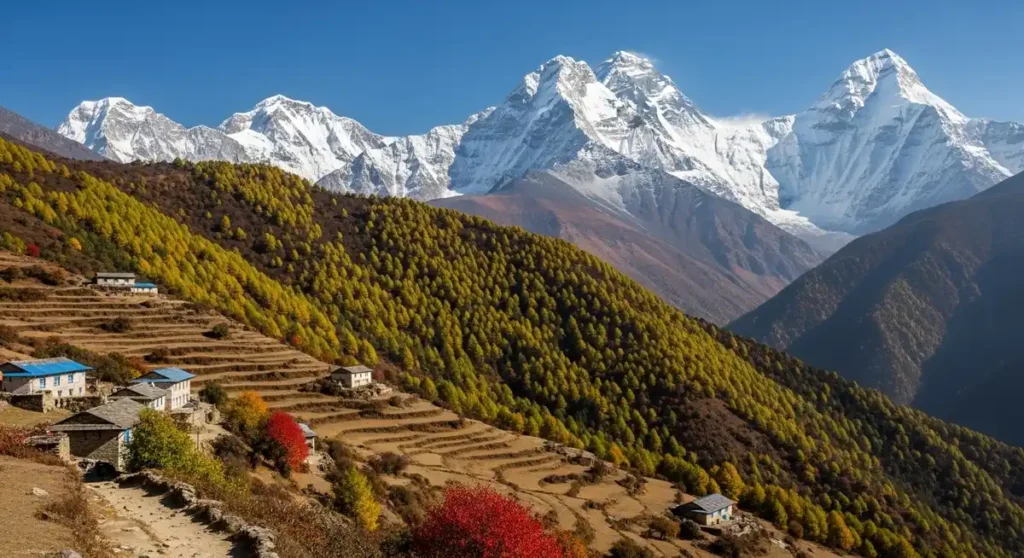
The dust is washed away, and the rhododendrons in spring (March to May) create a beautiful landscape. These warmer, longer days bring a sense of freshness and growth, making trekking and hiking enjoyable.
2. Visa & Entry Requirements
Traveling to Nepal is simple when you have the right documents ready. Most foreign nationals can get a Tourist visa on arrival at Tribhuvan International Airport or apply for an e-visa through the online portal before the trip.
Entry Requirements
- Valid passport with at least six months’ validity from the date of entry
- At least one blank page for the visa stamp
- Completed arrival card upon entering Nepal
- Visa application form filled online or at airport kiosks
- Proof of funds (such as a bank statement on the bank’s letterhead)
- Confirmed return or onward ticket
- Travel insurance document covering healthcare costs, repatriation, and emergencies
- Confirmation of first-night accommodation, such as a hotel booking
Visa Options
- 15-day tourist visa
- 30-day tourist visa
- 90-day tourist visa
- Transit visa for up to 24 hours
Additional Information
- SAARC citizens (except Afghanistan) may receive a 30-day visa free of charge once per visa year
- Gratis visas are available for Chinese nationals and children under 10 years old
- Afghan citizens can get a visa on arrival only with a recommendation from the Department of Immigration
- Visas can be extended for a maximum stay of 90 days at the Department of Immigration in Kathmandu
3. Vaccines & Health Prep
When planning a trip to Nepal, it’s important to have your routine immunizations like MMR, Tdap, polio, and chickenpox vaccines up to date. Adding Hepatitis A, Typhoid, Hepatitis B, Japanese encephalitis, rabies, and cholera to your itinerary offers wider protection.
Some are injectable and others oral, helping maintain good health and preventing contamination from food, water, or poor sanitation. These vaccinations also safeguard against viral diseases spread by mosquitoes in rural or suburban regions.
A travel health professional can guide you on the best precautions when visiting areas like the Terai and southern districts. Meeting them 4–6 weeks in advance ensures time for antimalarial medication if needed for extended stays.
To enjoy outdoor activities comfortably, use repellents with DEET or picaridin, wear protective clothing, and acclimatize to higher altitude above 2,500 meters.
Carry anti-diarrheal and anti-dehydration medication to manage traveler’s diarrhea and stay well in varying environmental conditions. Limiting exposure to blood and body fluids, and avoiding tattoos or piercings during travel, helps maintain overall wellness.
4. Packing List for a Safe Trip
A packing list for a safe trip in Nepal should include layered clothing for different weather, sturdy footwear, safety essentials like a first aid kit and water purification, important travel documents, personal care items, and reliable trekking gear. This ensures comfort, safety, and cultural respect during your Nepal journey.
🧥 Clothing & Layering
- Moisture-wicking t-shirts
- Long-sleeved shirts
- Thermal underwear
- Woolen sweaters
- Fleece jacket / Fleece outerwear
- Lightweight down jacket
- Waterproof rain jacket / Rainproof outerwear
- Warm beanie, Wool hat, Woolen beanie, Warm hat
- Insulated gloves, Waterproof gloves, Warm gloves
- Wool hiking socks, Wool socks, Woolen socks
- Quick-drying trekking pants / Waterproof pants
- Thermal trousers / Cold weather gear
👟 Footwear
- Sturdy hiking boots / Waterproof hiking boots
- Sports sandals
- Comfortable walking shoes / Comfortable trainers
- Wool socks thick for cold weather
- Spare laces
🥾 Trekking Gear
- Day backpack / Trekking backpack
- Waterproof backpack cover / Daypack waterproof cover
- Trekking poles / Trekking poles optional
- Trekking waterproof pants
- Trekking outer shell / Windproof fleece
- Trekking compass / Compass
- Trail map / Guidebook / Travel guidebook
- Microspikes / Crampons / Crampon spikes
- Camping gear / Tent camping gear
- Sleeping bag / Cold weather sleeping bag / Sleeping bag liner
- Sleeping clothes
- Hydration system / Hydration bottle
- Trail snacks / Trekking snacks local
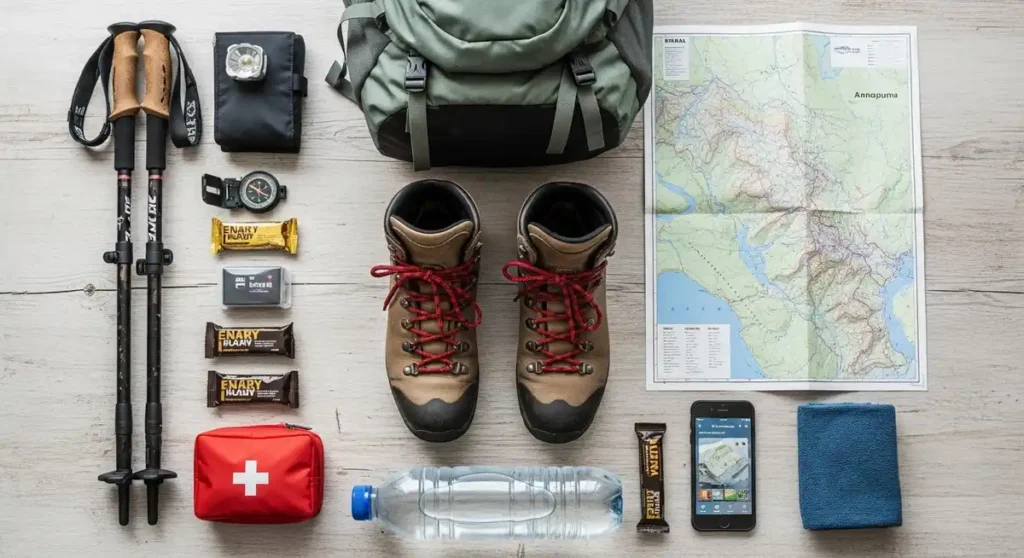
🛡️ Safety & Health
- First aid kit with aspirin, ibuprofen, antihistamines, antiseptic cream, imodium
- Personal medication / Emergency medication
- Altitude sickness medication
- Insect repellent / Mosquito repellent / Bug repellent DEET
- Insect bite ointment / Insect bite cream / Insect cream
- Hand sanitiser / Antibacterial gel / Antibacterial wipes
- Face masks
- Sun protection lotion / Sunscreen SPF30
- Lip balm with sunscreen
💧 Water & Hydration
- Reusable water bottle / Water bottle with filter / Water bottle refillable
- Water purification tablets / Water purification drops
- Electrolytes packets / Rehydration powder
📸 Electronics & Accessories
- Camera / Camera memory cards
- Portable charger / Power bank / Power bank portable
- Headlamp / Portable torch / Flashlight torch
- Spare batteries
- Mobile handset
- Travel adapter / Plug adaptors / Power adaptor C D / Power converter
- Portable lamp / Portable light
- E-reader
- Portable bluetooth speaker
💼 Documents & Money
- Passport photos / Medical certificates
- Hotel booking vouchers / Travel insurance
- Money belt / Cash / Cash for gratuities / Personal spending cash
🛠 Small Essentials
- Small padlocks
- Quick-drying washcloth / Microfiber towel
- Dry bags / Reusable waterproof bags / Waterproof bag for electronics
- Compact umbrella
- Notebook / Notebook and pen / Pen / Sketchbook / Travel journal
- Neck pillow
- Shawl for temple visits / Temple attire scarf / Temple modest dress / Temple appropriate scarf
- Modest clothing / Clothing for modesty
- Eco-friendly toiletries / Travel-sized shampoo / Personal toiletries / Toiletries
- Sewing kit / Drainage stopper / Detergent
Is Nepal Safer than Other Destinations?
Nepal is widely regarded as a safe travel destination, offering welcoming communities, peaceful environments, and well-known tourist spots like Kathmandu and Pokhara where visitors enjoy trouble-free experiences year-round.
With its friendly and hospitable population, Nepal provides a secure atmosphere for travelers seeking both cultural exploration and natural beauty. Popular destinations such as Kathmandu and Pokhara attract countless visitors who enjoy smooth, incident-free trips.
While every country has unique considerations, Nepal stands out for its strong sense of community and traveler-friendly environment. The nation’s rich cultural heritage, serene landscapes, and well-maintained attractions make it appealing for tourists from around the world.
Whether exploring bustling markets, trekking scenic trails, or visiting historical landmarks, visitors can expect a warm welcome and memorable experiences.
Is Nepal safer than India
Nepal is known for its peaceful atmosphere, friendly people, and strong community values, making it a welcoming place for visitors from India and around the world.
Traveling through Nepal offers a sense of ease and warmth. The Nepalese are calm, composed, and full of respect and generosity toward visitors, especially those from India.
Streets have fewer automobiles, making the environment relaxed and helping keep crimes very low. As an Indian citizen, visiting feels like moving between familiar places in the safest country to visit any time of the year.
The nation values non-violence and follows thoughtful policies that limit access to fire-arms. This fosters a secure space for everyday life. Many young men work outside the country or focus on local activities that help them earn a living.
These strong ties to employment and positive opportunities contribute to the overall safety, making Nepal a uniquely welcoming destination compared to India.
Conclusion
Nepal is a peaceful and safe country for travellers, families, solo female visitors, and expats. With friendly local people, rich culture, and scenic places like Kathmandu, it offers memorable travel experiences. Following simple precautions and enjoying tours, public transport, and hiking make your trip truly special.
Nepal welcomes travellers from all over the world. The local culture is warm, and people greet foreigners with kindness. From busy streets in Kathmandu to peaceful mountain trails, there’s so much to enjoy around the country. Exploring bars, places, and scenic spots with friends makes the journey even more memorable. The government and US State Department share advice and tour tips online, which help you plan better.
Whether you’re travelling for a tour, hiking adventure, or simply to enjoy the public atmosphere, Nepal offers a safe and inviting environment. With exercise and light precautions, you can enjoy night outings, taxi rides, and transport with ease. The beauty of Nepal, its peaceful vibe, and its welcoming travellers make it a wonderful place to explore at any level of travel experience.
FAQs — People Also Ask
Is Nepal a safe country for tourists?
Yes, Nepal is safe for tourists. The people are friendly, and the crime rate is low. Tourist areas like Kathmandu and Pokhara have good services. Guides and hotels help make the trip easy and enjoyable.
What are the risks in Nepal?
The main risks are changes in altitude, busy areas, and weather changes. Staying with trusted guides and using safe transport helps. Keep belongings secure and plan for different weather.
When not to go to Nepal?
The monsoon season from June to September has heavy rain. This can cause landslides and floods. Travel is better in dry months for safe trekking and sightseeing.
Which is safer, India or Nepal?
Nepal is calmer and less crowded than India. The streets are quieter, and people are peaceful. Many visitors find it more relaxed and easy to explore.
Is Nepal safe for Americans?
Yes, Nepal is safe for Americans. Locals are welcoming, and tourist spots are well-prepared. Guides, hotels, and transport services help make travel smooth.
Can you drink tap water in Nepal?
No, it’s better to drink bottled or purified water. This keeps you healthy. Boiled water is also safe in most places.
Is bus travel safe in Nepal?
Yes, bus travel is safe in daylight hours. Tourist buses and private jeeps are comfortable. Keep your bag close and enjoy the views on the way.
Is Kathmandu safe at night?
Yes, Kathmandu is safe in main areas at night. Places like Thamel have many people and lights. Use a taxi app if going far.
Which areas of Nepal should be avoided?
Avoid remote mountain paths in bad weather. During monsoon, skip landslide-prone roads. Stay on popular trekking routes with guides.
How safe is trekking alone in Nepal?
Trekking alone is safe on busy trails with a guide. Carry a map, water, and tell someone your route. Guided treks are the safest choice.
Is Nepal safe for ladies?
Yes, Nepal is one of the safest Asian countries for women. Locals are respectful, and tourist spots are friendly. Using common sense makes travel smooth.
Is Nepal cheap to visit?
Yes, Nepal is budget-friendly. Hotels, food, and transport are affordable. You can travel well even with a small budget.
Disclaimer
Information in this guide is for general travel purposes only. Safety conditions can change, so always check current advisories before your trip. Traveldrizzle.com is not responsible for any decisions made based on this content.
